Homer IPTs Info
Two folks are interested in the second Homer IPT. If you’ve been thinking of attending one of the great trips below, please contact me via e-mail to learn of the Late Registration Discounts; I will do my very best to make it happen.
|
|
All images from Homer or Kachemak Bay, AK |
2023 Homer/Kachemak Bay Bald Eagle IPTs
IPT #1: MON 20 FEB 2023 through the full day on FRI 24 FEB 2023. Five full days/20 hours on the boat: $5500.00. Limit 5 photographers/Openings: 2.
IPT #2: SAT 25 FEB 2023 through the full day on THURS 2 MAR 2023. Six full days/24 hours on the boat: $6600.00. Limit 5 photographers/Openings: 3.
IPT #3: FRI 3 MAR 2023 through the full day on TUES 7 MAR 2023. Five full days/20 hours on the boat: $5500.00. Limit 5 photographers. Openings: 2.
Save $1,500.00 by doing back-to-back trips. Save $2500 by doing all three trips.
These trips feature non-stop flight photography as well as many opportunities to create both environmental and point-blank portraits of one of North America’s most sought-after avian subjects: Bald Eagle (Haliaeetus leucocephalus). Other reliable subjects will include Sea Otter, Glaucous-winged and Short-billed (formerly Mew) Gulls.
In addition, we should see Common Murre, Black Guillemot, Pelagic Cormorant, two or three species of loons, and a smattering of ducks including two species of merganser, all three scoters, Common and Barrow’s Goldeneyes, Bufflehead, Harlequin, and Long-tailed Ducks. Close-range photographic chances for these species will require a ton of good luck. Some of these species, especially when in flocks, can, however, often be used effectively when creating bird-scapes.
If we need to be out early, we will be the first boat out. If conditions are great, we will stay out. And when there is a chance for sunset silhouettes, we will stay out and be in the right spot.
We will be traveling through gorgeous wilderness country; landscape and scenic opportunities abound.
Also featured is a professional leader, often referred to as the world’s most knowledgeable bird photography trip leader, who is conversant in Canon, Nikon, and Sony.
|
|
All images from Kachemak Bay in 2022! |
What You Will Learn
You will learn practical and creative solutions to everyday photographic problems. You will learn to see the shot, to create dynamic images by fine-tuning your compositions, to best utilize your camera’s AF system, and how to analyze the wind, the sky conditions, and the direction and quality of the light. This is one of the very few trips Homer trips available where you will not be simply put on the birds and told to have fun. You will learn to be a better photographer. But only if that is what you want.
You will learn to get the right exposure when it is sunny, when it cloudy-bright, when it is cloudy, when it is cloudy-dark, or when it is foggy. Not to mention getting the right exposure when creating silhouettes.
You will learn to make pleasing blurs working in manual mode and to create silhouettes working in Shutter Priority mode.
Most importantly you will learn to pick your best flight images from tens of thousands of images.
You will enjoy working with the two best and most creative boat captains on their sturdy, photography-spacious, seaworthy, open-deck crafts.
The second and third IPTs are the only Bald Eagle workshops that feature an incredibly helpful first mate.
Only five photographers (not the usual six), plus the leader.
Small group Photoshop, Image Review, and Image Critiquing sessions.
|
|
All images from Homer or Kachemak Bay, AK |
What’s Included
One four-hour, or two two-hour (+/-), boat trips every day (weather permitting), all boat fees and boat-related expenses (excluding tips), ground transportation to and from the dock and back to the hotel each day, in-the-field instruction and guidance, pre-trip gear advice, small group post-processing and image review sessions, and a thank you dinner for all well-behaved participants. Airport pickup if possible)
What’s Not Included
Your airfare to and from Homer, AK (via Anchorage), the cost of your room at Land’s End Resort, all personal items, all meals and beverages, and tips for the boat captain and/or the first mate.
Please Note
On great days, the group may wish to photograph for more than four hours. If the total time on the boat exceeds 20 hours for the five-day trips, or 24 hours for the second trip, the group will share the additional expense at a rate of $225/hour.
Some folks may wish to rent their own vehicle to take advantage of local photographic opportunities around Homer.
Deposit Information
A $3000 non-refundable deposit/trip is required. You may pay your deposit with credit card or by personal check (made out to BIRDS AS ART) and sent via US mail only to Arthur Morris. PO Box 7245. Indian Lake Estates, FL 33855. Your balance, due 90 days before the date of departure, is payable only by check as above.
In Closing
I have been going to Homer off and on for close to two decades. Every trip has been nothing short of fantastic. Many folks go in mid-March. The earlier you go, the better the chances for snow. The only way to assure that you are on the best of the three trips is to sign up for all three. Can you keep up with me? If you have any questions, or are good to go for one, two, or all three trips, please let me know via e-mail or give me a call on my cell phone at 863-221-2372.
What’s Up?
Not much. The lake was pretty much dead on Tuesday morning and it clouded over at sunset. I was shocked that once again, nobody even took a stab at the f/2.8 depth of field question.
It’s a given that you will enjoy unbelievable eagle photography on a Homer IPT. What most folks do not realize is that they will learn a ton about picking their keepers out of many thousands of images and improve their Photoshop skills by leaps and bounds. Think I’m kidding? One guy shot more than 20,000 images in a single morning. It was great, but I only created 3,417 during that session.
Today is Wednesday 14 December. The forecast for the morning is for partly cloudy skies with an ESE breeze so I will at least give it a go. This blog post took about 90 minutes to prepare and makes two hundred sixty-two days in a row with a new, educational post just for you. Wherever you are and whatever you are doing, I hope that you too have a great day.
Please remember to use the B&H and Amazon links that are found on most blog pages and to use the BIRDSASART discount code at checkout when purchasing your new gear from Bedfords to get 3% back on your credit card and enjoy free second-day air FedEx. Please, also, consider joining a BAA IPT. You will be amazed at how much you will learn!
You can find some great photo accessories (and necessities, like surf booties!) on Amazon by clicking on the Stuff tab on the orange/yellow menu bar above. On a related note, it would be extremely helpful if blog-folks who, like me, spend too much money on Amazon, would get in the habit of clicking on the Amazon logo link on the right side of each blog post when they shop online. As you might expect, doing so will not cost you a single penny, but would be appreciated tremendously by yours truly. And doing so works seamlessly with your Amazon Prime account.
Please remember that if an item — a Delkin flash card, or a tripod head — for example, that is available from B&H and/or Bedfords, is also available in the BAA Online Store, it would be great, and greatly appreciated, if you would opt to purchase from us. We will match any price. Please remember also to use my B&H affiliate links or to earn 3% cash back at Bedfords by using the BIRDSASART discount code at checkout for your major gear purchases. Doing either often earns you free guides and/or discounts. And always earns my great appreciation.
|
|
|
This image was created on 22 February 2020 on an Instructional Photo-Tour at Kachemak Bay, Homer, AK. I used the hand held Sony 70-200mm f/2.8 lens (now replaced by the Sony FE 70-200mm f/2.8 GM OSS II lens) with the Sony FE 1.4x Teleconverter (at 216mm) and the Sony a9 II (now replaced by The One, the Sony Alpha 1 Mirrorless Digital Camera.) The exposure was determined via Zebras. ISO 1600: 1/2000 sec. at f/4.5 (stopped down 1/3-stop) in Manual mode. AWB at 3:39:33pm on a cloudy afternoon. Zone AF/C performed perfectly. Click on the image to enjoy a high-res version. Image #1: Bald Eagle landing at my favorite perch in Kachemak Bay |
My Favorite Kachemak Bay Bald Eagle Perch
I found this perch near a tiny, secluded, out-of-the way cove. There is one house high up on a cliff and several boats are moored in the small bay. I love the lichens and there are always lots of eagles around. The trick is to be there on the right wind — north/northeast. Cloudy with snow is best for this spot. Join me on one of the Homer IPTs and I promise to take you to this magical spot.
Click to Enlarge!
Be sure to click on Image #1 to see the larger, sharper hi-res version. The bird was squinting as it landed so its left eye, the one on our right, was barely visible. So, I took painted a Quick Mask of the eagle’s right eye, flopped it, moved it roughly into place, and then, using the Transform Tool, rotated it. Perfecto! All as detailed in Digital Basics II and in APTATS I & II.
|
|
|
This image was also created on 22 February 2020 on an Instructional Photo-Tour at Kachemak Bay, Homer, AK. Again, I used the hand held Sony 70-200mm f/2.8 lens (now replaced by the Sony FE 70-200mm f/2.8 GM OSS II lens) with the Sony FE 1.4x Teleconverter (at 127mm) and the Sony a9 II (now replaced by The One, the Sony Alpha 1 Mirrorless Digital Camera.) The exposure was determined via Zebras. ISO 1600: 1/2000 sec. at f/4.5 (stopped down 1/3-stop) in Manual mode. AWB at 3:54:12pm on a cloudy afternoon. Zone AF/C performed perfectly. Click on the image to enjoy a high-res version. Image #2: Bald Eagle on my favorite perch in Kachemak Bay |
The 70-200mm f/2.8 Lenses Rock in Kachemak Bay
All the 70-200mm f/2.8 lenses (but for the Canon RF version that does not accept either TC) offer incredible versatility in a small, light package. At Homer, you can use the prime lens alone for flight on very dark mornings. You can add a 1.4X TC for a bit of extra reach and still be at f/4 for low light flight photography. And on sunny mornings, you can add the 2X TC to get to 400mm f/5.6. These lenses are great for small-in-the-frame bird-scapes like Image #2. And they are hugely popular among the pros for creating landscapes, townscapes, people, and just about everything else including ships. It is a great walk-around lens. The new Sony version II is the best I’ve ever used. Autofocus with the a1 is science-fiction-like.
|
|
|
This image was created on 22 February 2020 on an Instructional Photo-Tour at Kachemak Bay, Homer, AK. I used the hand held Sony FE 70-200mm f/2.8 GM OSS II lens (at 116mm) and the A7R IV, (now replaced for me by The One, the Sony Alpha 1 Mirrorless Digital Camera.. The exposure was determined via Zebras with Exposure Compensation on the thumb dial. ISO 6400: 1/400 sec. at f/6.3 (don’t ask me why!) in Manual mode. AWB at 5:02:29pm in a blizzard. Spot S AF/C performed perfectly. Click on the image to enjoy a high-res version. Image #3: Ship up on blocks, Homer Spit, AK |
And Ships!
After a long day of great eagle photography, the light snow turned into a blizzard. Several of us got into the big SUV and drove around looking for something, anything, to photograph in the storm. This big ship up on blocks was my favorite from that evening.
Your Call?
Which of today’s three featured images do you like best? All are invited to leave a comment and let us know why they made their choice.
Typos
With all blog posts, feel free to e-mail or to leave a comment regarding any typos or errors.

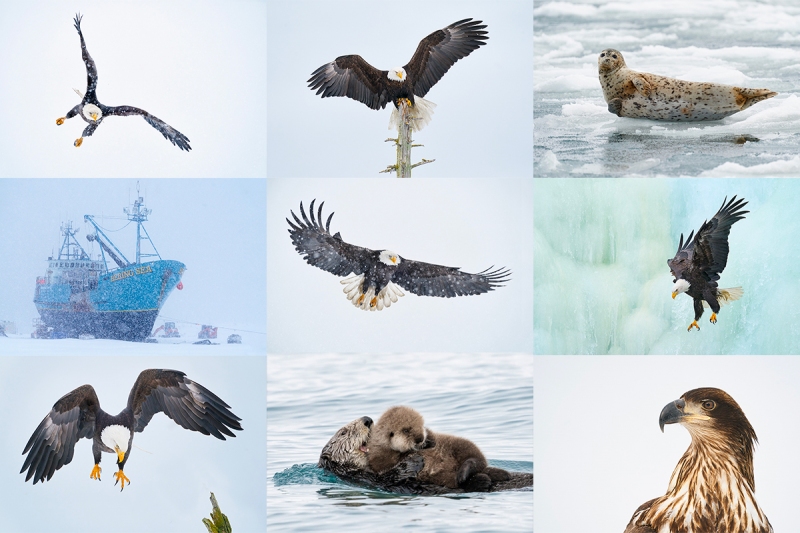
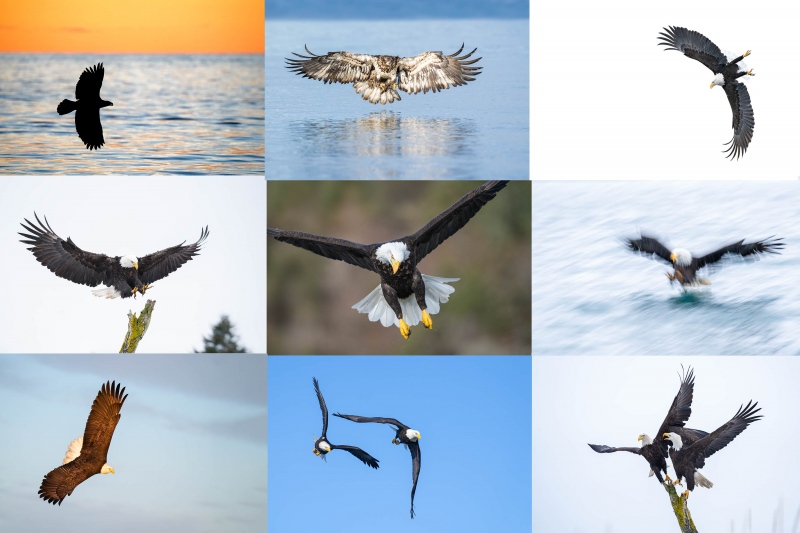
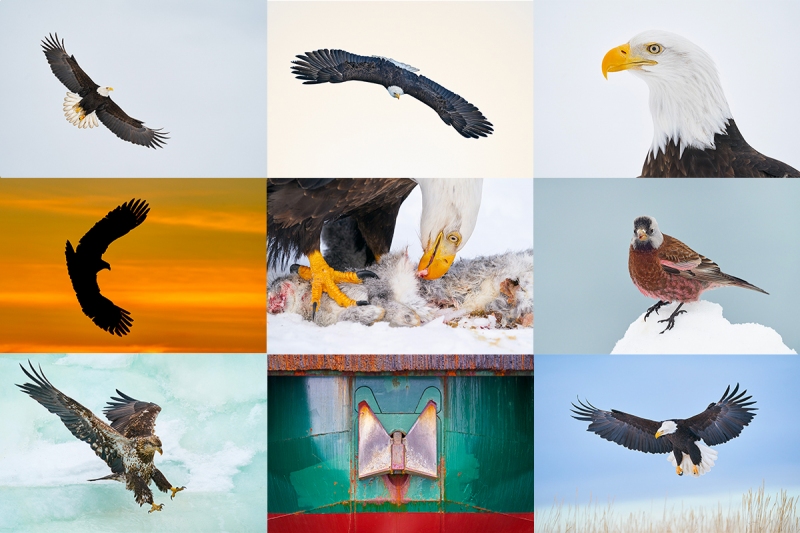
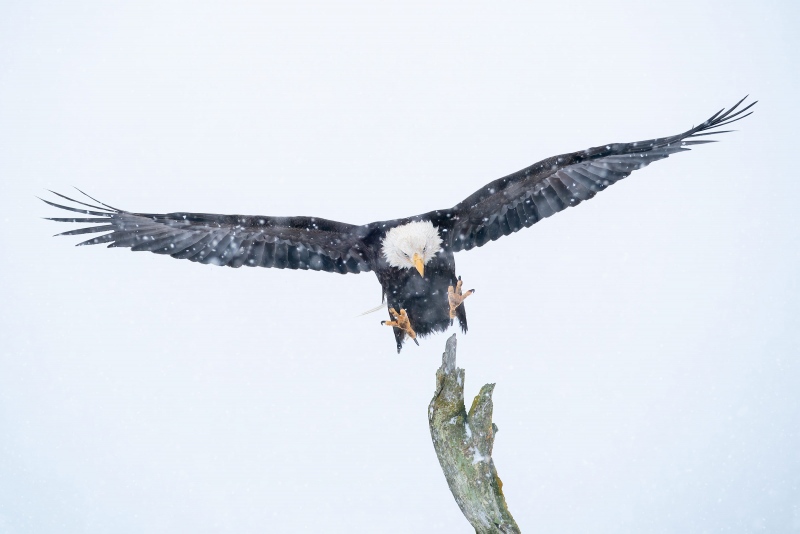
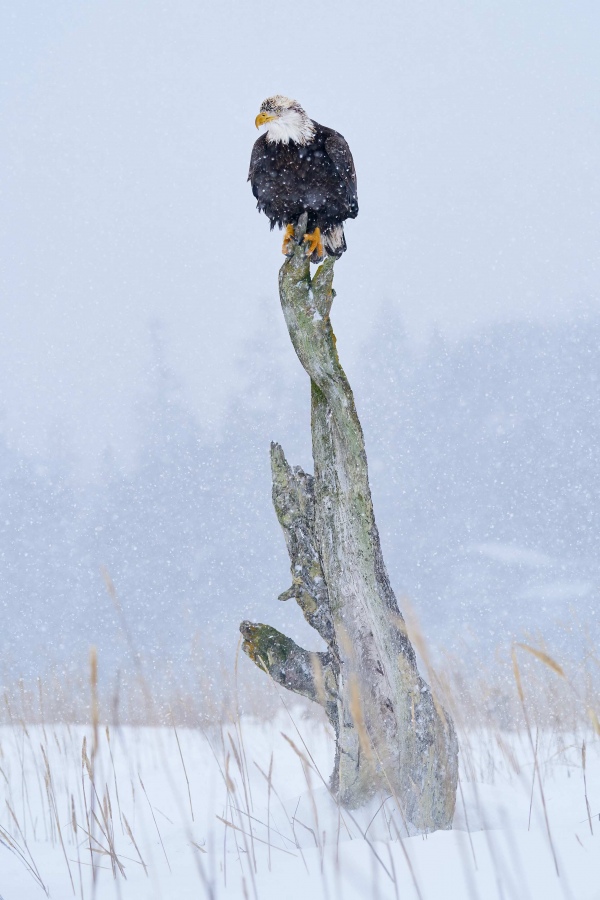
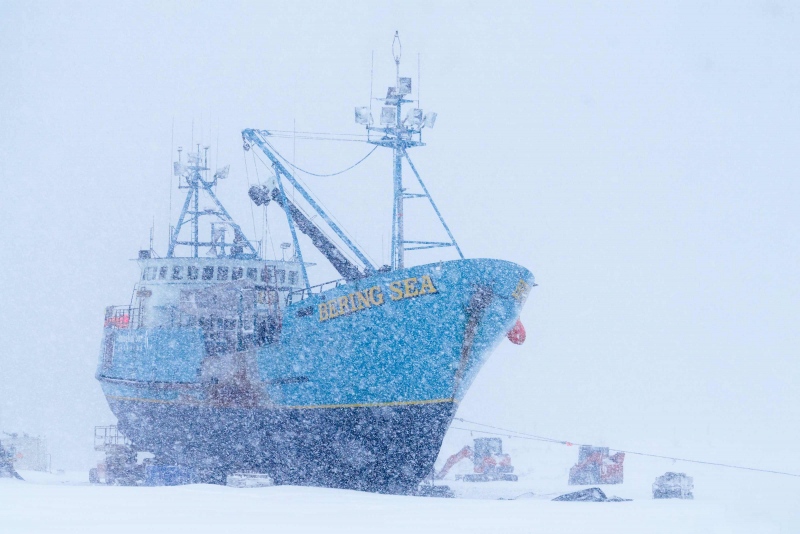













Total depth of field would be 100 meters with 45 meters in front of the subject and 65 behind the subject in focus. I’m rounding a bit.
Bob P
Yup. That is more than 328 feet of dof. At f/2.8. It is all about the distance to the subject.
a
Very good!
ilove them all
the ship looks like a picture from a scary movie
I’m not sure of the lens you were asking about but the Dof of a 400mm 2.8 lens with a 2X converter at 316 meters or about 1000 ft. would be 80 feet according to Photopils.
Bob P
Hi Bob,
It was in reference to these two blog posts:
https://www.birdsasart-blog.com/2022/12/13/the-eagle-nest-tree-the-depth-of-field-question-again/
and this one:
https://www.birdsasart-blog.com/2022/12/10/it-was-the-frogs-fault/
Both images made with the 400 f/2.8 wide open.
with love, artie
The f/2.8 question: the subject was far enough away that even at f/2.8, everything was within the depth-of-field.
Excellent. Do you have any idea on the total depth of field if the lens is focused to 316.24 meters?
with love, artie
The ship does it for me. I love the eagles but the ship in drydock with the colors and snow flying put it over the top for me. Thanks for sharing.
Thanks, Jim. That was quite a day.
with love, artie
Artie
The snow really does add to the photos especially the ship, i like them all and the Eagle to film is amazing i bet. There size and grace yet a symbol of strength as most all birds give them plenty of room. Can you say I’ll see you in Homer! It’s the frogs fault 🙂
Always with love b